History of Etruscan Sarcophagus of the Spouses: Unveiling Etruscan Funerary Art
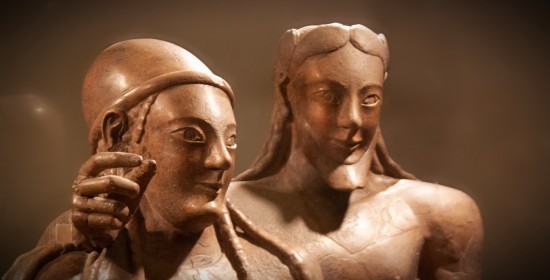
Welcome to Stefano’s RomeCabs, your premier provider of luxury private tours of Rome from the cruise ship. Shore Excursions from Civitavecchia offer captivating itineraries that allow you to uncover the wonders of ancient Etruscan civilization.
Embark on a journey to explore the ancient tombs in Cerveteri's Banditaccia Necropolis featured on our Post Cruise Countryside Splendor Tour where the famous Sarcophagus of the Spouses was discovered. Marvel at the breathtaking 2,500-year-old frescoes that adorn the underground tombs of Monterozzi Necropolis in Tarquinia, offering a glimpse into the artistic brilliance of the Etruscans. Additionally, visit magnificent towns that were once thriving Etruscan cities in the Roman countryside, once renowned as the region of "Etruria".
In the realm of ancient art and culture, few artifacts possess the mystique and historical significance of the Etruscan Sarcophagus of the Spouses from Cerveteri. This remarkable sarcophagus, currently housed in the Villa Giulia museum, holds profound significance in studying ancient civilizations.
In this blog titled "History of Etruscan Sarcophagus of the Spouses: Unveiling Etruscan Funerary Art," we invite you to embark on a remarkable digital journey through time and immerse yourself in the mesmerizing allure of ancient Etruscan art that awaits you on our day tours from Rome and private excursions from Civitavecchia to ancient Etruscan wonders.
History of Sarcophagus of the Spouses
Who were the Etruscans?
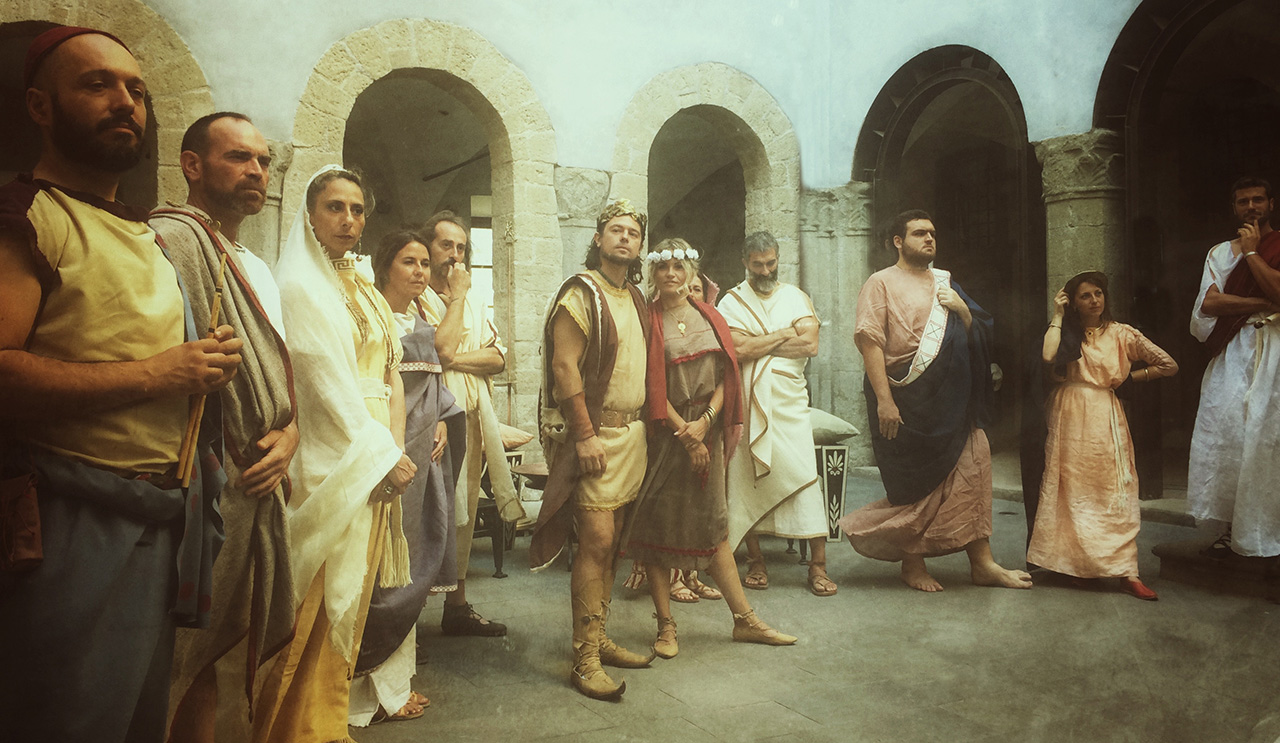
The Etruscans were an ancient civilization that flourished in Italy between the 8th and 3rd centuries BCE. They inhabited the region known as Etruria, which encompassed parts of present-day Tuscany, Umbria, and Lazio.
The Etruscans were highly skilled in various fields, including art, architecture, engineering, and commerce. The Etruscans possessed exceptional maritime skills and were adept seafarers with a profound understanding of ships and navigation. They had their own unique language and writing system, which remains largely undeciphered. The Etruscans were known for their sophisticated culture, elaborate burial practices, and strong influence from the Greeks.
The Etruscans played a significant role in shaping the early development of Rome. Before Rome became a republic, it was a monarchy led by seven legendary Kings, three of the Kings of Rome were Etruscan. The Etruscans exerted a profound influence on Roman society, surpassing Rome in various aspects. Their art, religious beliefs, engineering advancements, city planning, and social customs shaped and impacted Roman civilization significantly. Despite the eventual assimilation of the Etruscans into the Roman Empire, their legacy continues to fascinate and intrigue archaeologists, historians, and art enthusiasts to this day.
What is a Sarcophagus?
A sarcophagus is a stone coffin, typically adorned with intricate carvings and designs, used to house the remains of the deceased in various ancient civilizations.
The word "sarcophagus" itself originates from the Greek words "sarx" meaning flesh and "phagein" meaning to eat, reflecting the belief that the flesh of the deceased would be consumed by the earth over time.
Etruscan sarcophagi were often designed to resemble beds or couches, with the deceased lying in a reclining position. This portrayal emphasized the Etruscans' belief in the continuation of relationships and companionship in the afterlife.
Etruscan sarcophagi were also frequently adorned with intricate decorations and inscriptions, further showcasing the Etruscans' attention to detail and their desire to convey important messages or symbols associated with the deceased.
On our Etruscan Tours to Cerveteri and Tarquinia, you would discover countless sarcophagi on display at local archaeological Etruscan Museums, or also throughout towns like Tuscania (an ancient Etruscan city).
History of the Etruscan Sarcophagus of the Spouses
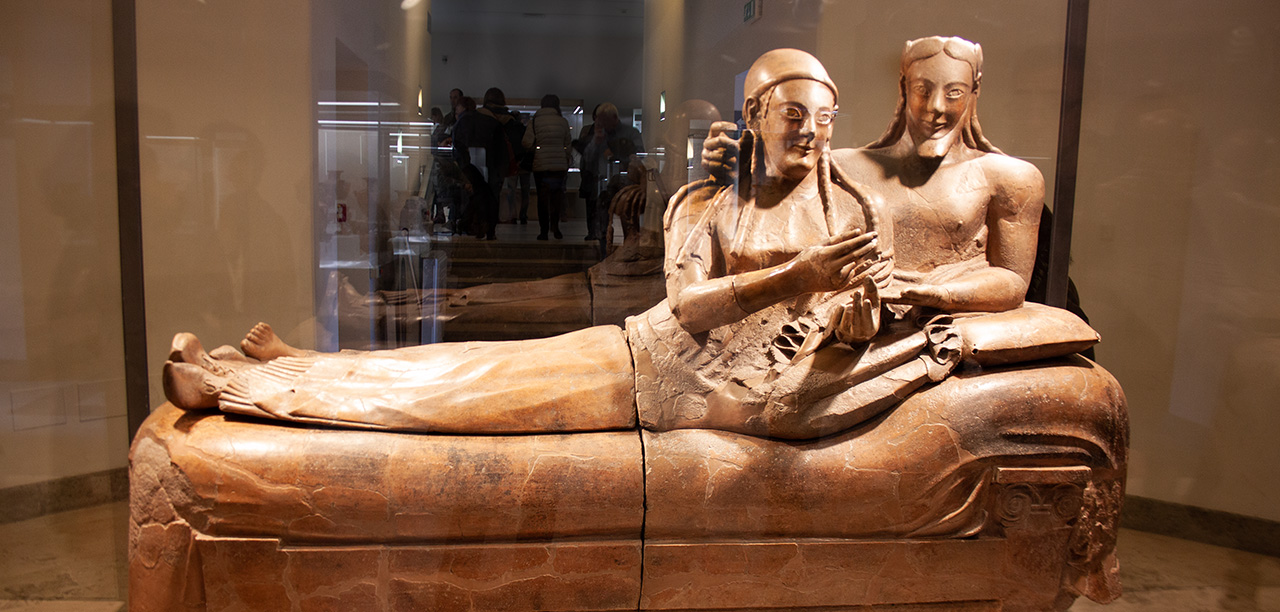
Regarded as one of the most exceptional masterpieces of its kind, Sarcophagus of the Spouses (in Italian Sarcofago degli Sposi) is a testament to the artistic prowess and cultural richness of the ancient Etruscan civilization. This funeral urn of polychrome terracotta from the 6th century BC stands 1.4 meters high and 2 meters long.
Renowned for their mastery of terracotta sculptures and funerary art, the Etruscans crafted exquisite sarcophagi and urns. Among these treasured works, the Sarcophagus of the Spouses stands as a remarkable example. This anthropoid sarcophagus was discovered at in the ancient Etruscan city of Caere (modern-day Cerveteri) in the Banditaccia necropolis which became a UNESCO World Heritage Site, and now finds its home in the esteemed National Etruscan Museum of Villa Giulia in Rome.
The sarcophagus takes the form of a reclining couple, their bodies sculpted with remarkable artistry, forever immortalized in an eternal embrace within their final resting place.
The Sarcophagus of the Spouses not only showcases the Etruscans' exceptional craftsmanship but also offers insights into their beliefs and customs surrounding death and the afterlife. It serves as a poignant reminder of the importance they placed on honoring and commemorating their loved ones.
Discovery & Preservation of Sarcophagus of the Spouses
The discovery and preservation of the Sarcophagus from Cerveteri have played a pivotal role in our understanding of Etruscan culture. This remarkable artifact has not only shed light on the ancient burial practices of the Etruscans but has also contributed to our knowledge of their artistic achievements.
In the 19th century, archaeology attracted the attention of a select group of cultural elites and became a lucrative endeavor for landowners and art merchants. In 1881, the Boccanera brothers made their significant discovery on the Ruspoli family estate, which is now known as the Banditaccia Necropolis.
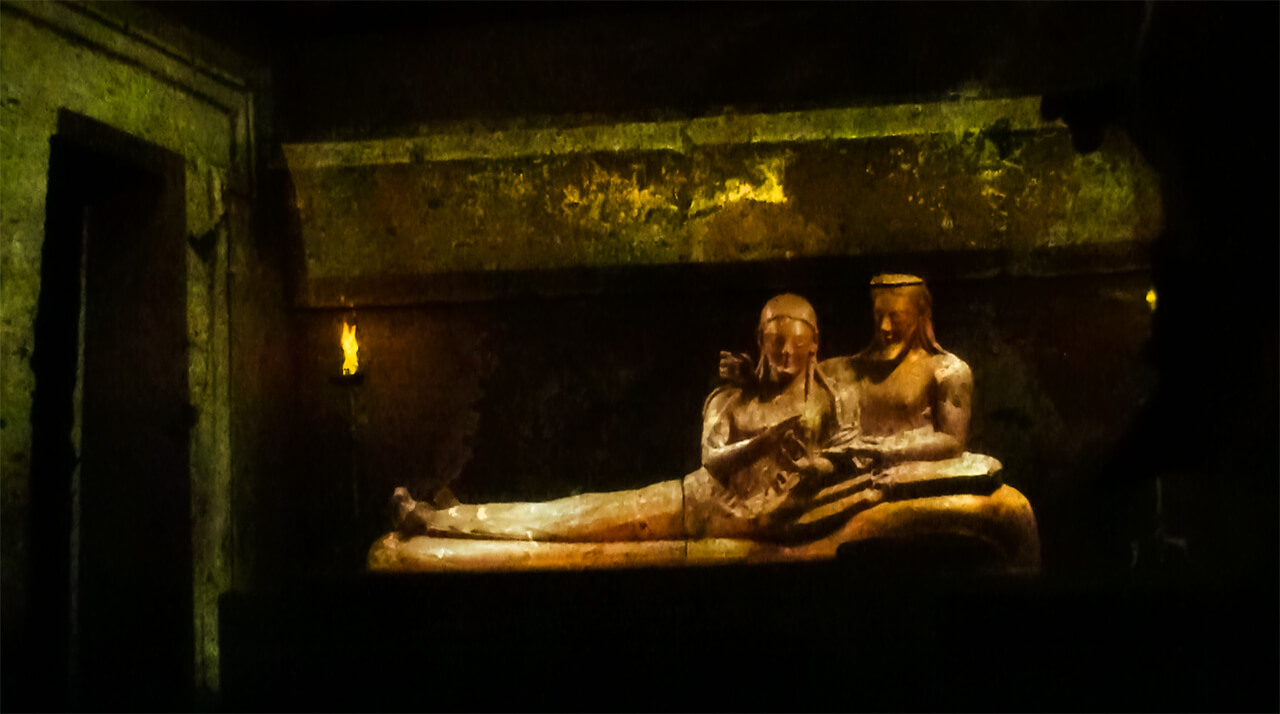
They found the Sarcophagus of the Spouses broken into about 400 fragments, scattered both inside and outside the tomb. Unfortunately, the tomb had already suffered considerable damage from previous excavations, possibly by tomb raiders. Alongside the sarcophagus, a group of Corinthian vases was also found, serving as accompanying artifacts.
In the mid-1950s, the collaboration between Renato Bartoccini and engineer Maurilio Lerici resulted in the restoration of the Sarcophagus of the Spouses. This restoration project was just one among many innovative endeavors undertaken during that time.
Thanks to the dedication and expertise of these professionals, the Sarcophagus of the Spouses was successfully restored and displayed at the National Etruscan Museum of Villa Giulia. Visitors have the opportunity to admire the exquisite craftsmanship and artistry of this remarkable Etruscan funerary artwork.
Preserving the artifact for future generations is challenging.
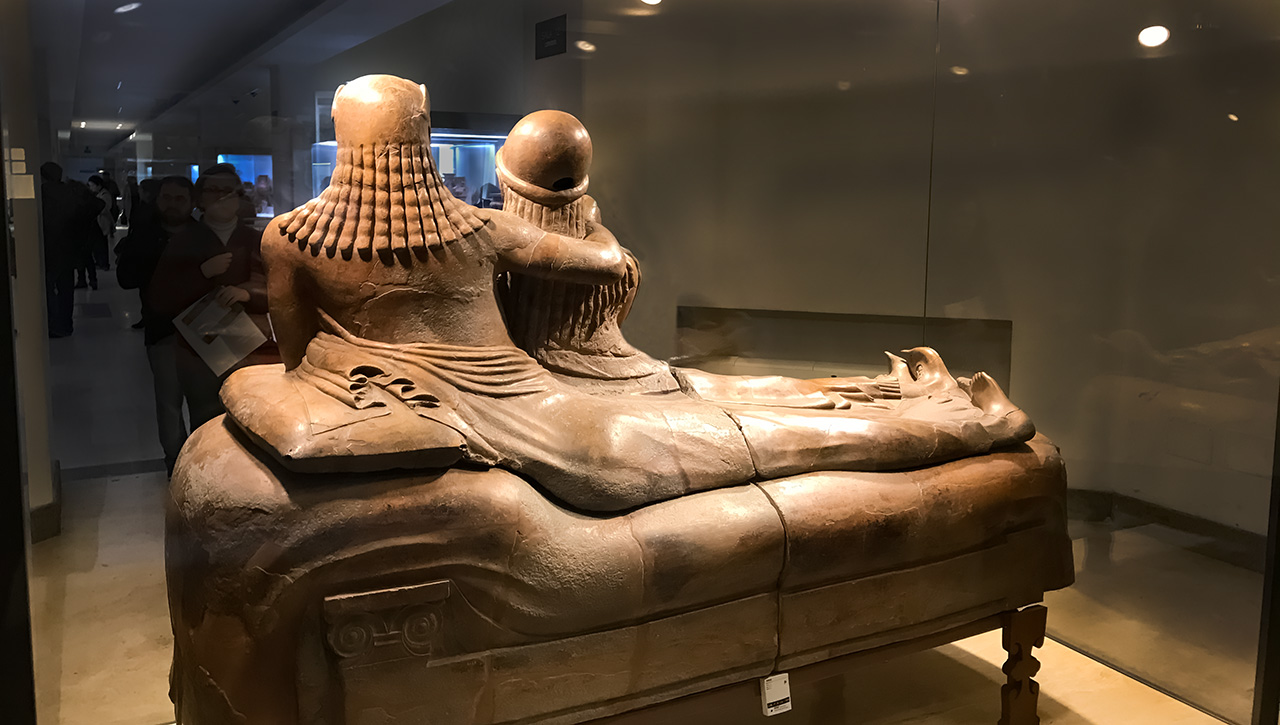
Traffic-induced vibrations deteriorate historic buildings and their contents over time. The Sarcophagus of the Spouses and other artworks in the north wing of the museum is at risk of stability issues due to the daily vibrations from rail traffic.
Earthquakes also pose a significant threat to artistic and historical treasures. Assessing their vulnerability requires a detailed examination of their dynamic properties and seismic vulnerability.
To address these challenges, adopting seismic isolation is an intelligent solution. It involves reducing dynamic loads at the base of the artwork instead of solely increasing its resistance, offering protection and limiting damage even during violent seismic events.
Artistic Splendor and Craftsmanship
The Sarcophagus of the Spouses is a mesmerizing terracotta masterpiece that once gleamed with vibrant colors. This ancient treasure tells a timeless tale of love and companionship, portrayed by a man and a woman reclining upon intricately designed cushions, mirroring the authentic banquet setting. The sarcophagus body is crafted to resemble a kline, a dining couch, adding to its artistic allure.
Their elongated body proportions evoke the artistic conventions of the Archaic period in the Mediterranean region.
Upon closer inspection, a distinctive vertical line traverses the middle of the sarcophagus, hinting at its construction from separate pieces meticulously fused together. Crafted with meticulous care, the Sarcophagus of the Spouses was painstakingly brought to life through the firing of its four separate pieces, each carefully assembled to create this magnificent work of art.
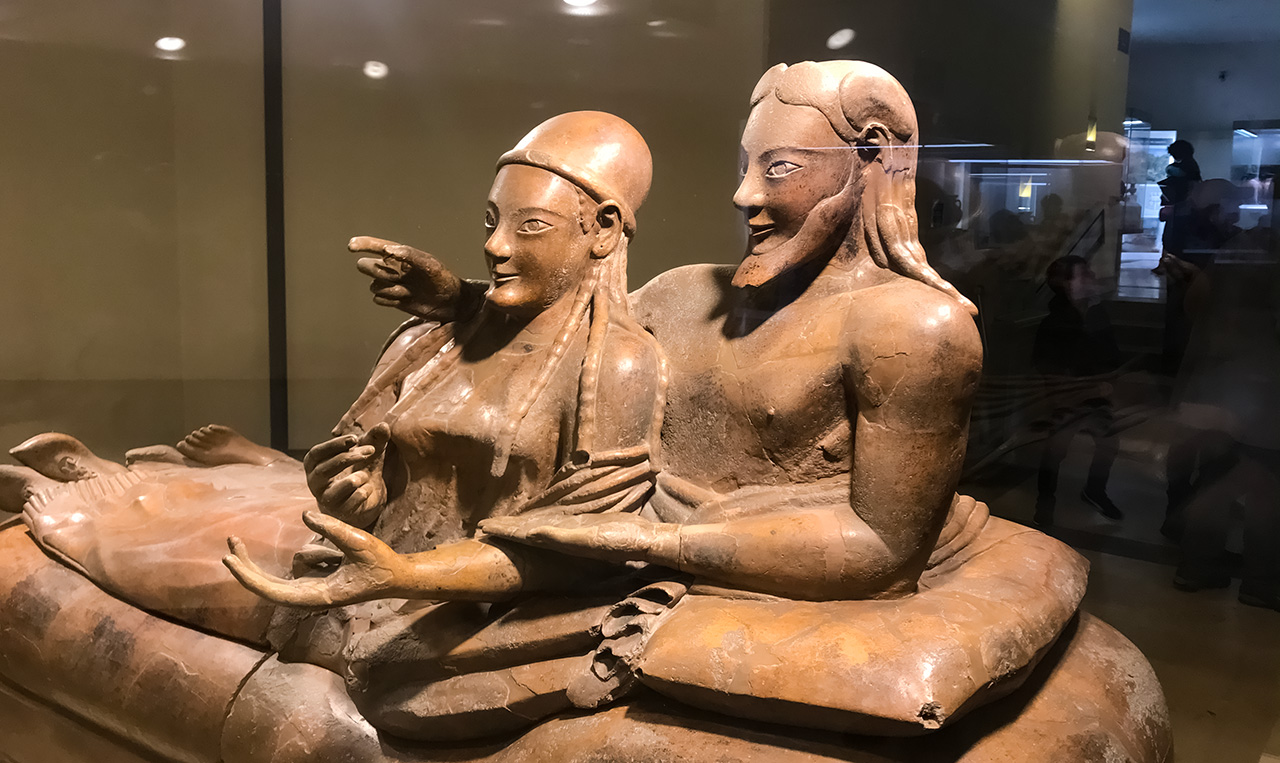
The intricate details of their meticulously styled hair are noteworthy. The faces of the couple beam with joy, their almond-shaped eyes reflecting profound happiness and that enigmatic “Etruscan smile”. It is a testament to the skill of the Etruscan artisans who brought this scene to life.
Subtle nuances that differentiate the man and woman demand attention. The woman's braids cascade over her shoulders, gently framed by a soft cap (tutulus), while the man's braids gracefully fan out across his shoulders and back.
The male figure's beard and the hair on his head are artistically simplified, lacking intricate details.
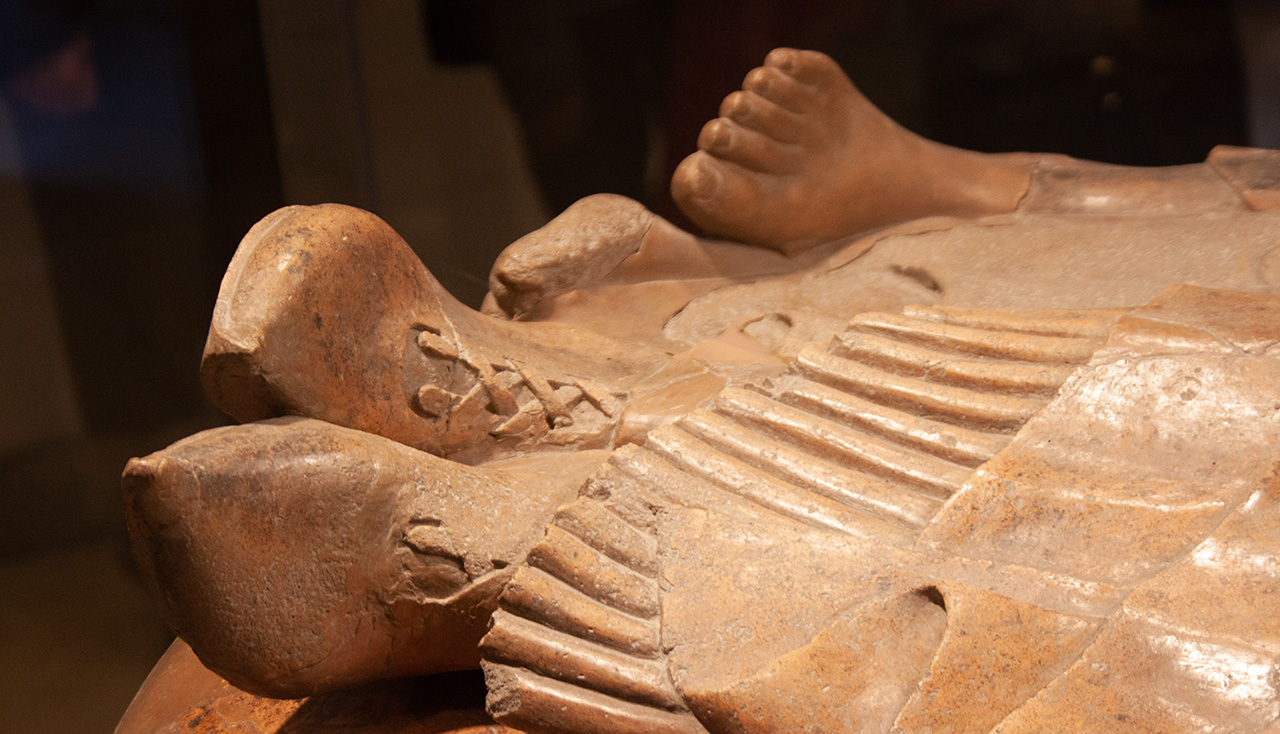
The legs and hips of the figures are artfully stylized to harmoniously fit the lid's contours, revealing only the subtlest hints of their feet. The woman wore shoes known as calcei repandi, a type of Etruscan footwear with a sole, shoe laces, and a pointed toe bent upwards that reflected Eastern fashion trends. The man was depicted barefoot.
The striking juxtaposition between the high-relief busts and the flattened legs is quintessentially Etruscan, showcasing their unique artistic sensibilities. The expressive faces and arms of the upper half of the figures captivate the imagination, drawing you into their fascinating narrative.
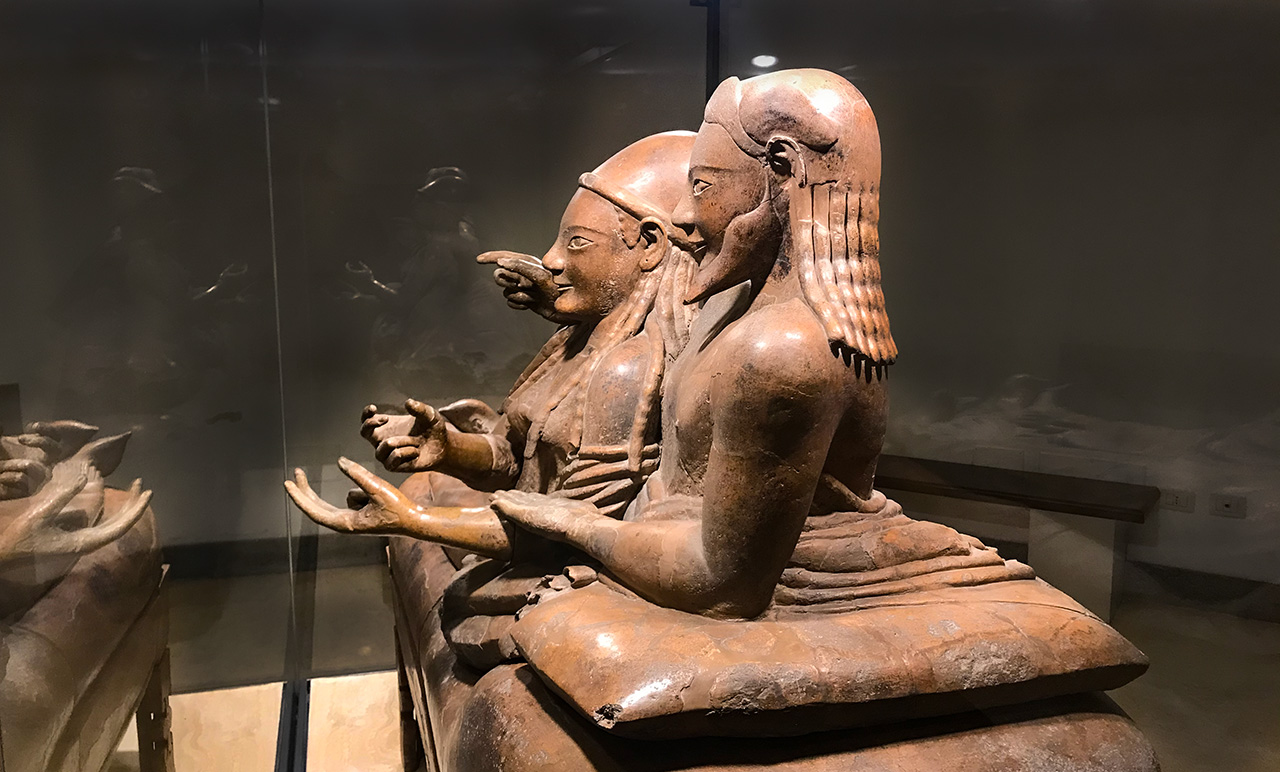
Regrettably, the hands of the couple depicted in the Sarcophagus of the Spouses have suffered damage, resulting in the loss of whatever objects they were originally holding in their hands as an "offering".
Although it is now difficult to ascertain with certainty, it is believed that the couple's hands may have held items associated with banquets, such as wine cups or food offerings.
Alternatively, it is possible that the woman was engaged in a ritual anointing, a practice of great funerary importance, while the man might have been holding a plate or garlands as seen in other sarcophagi.
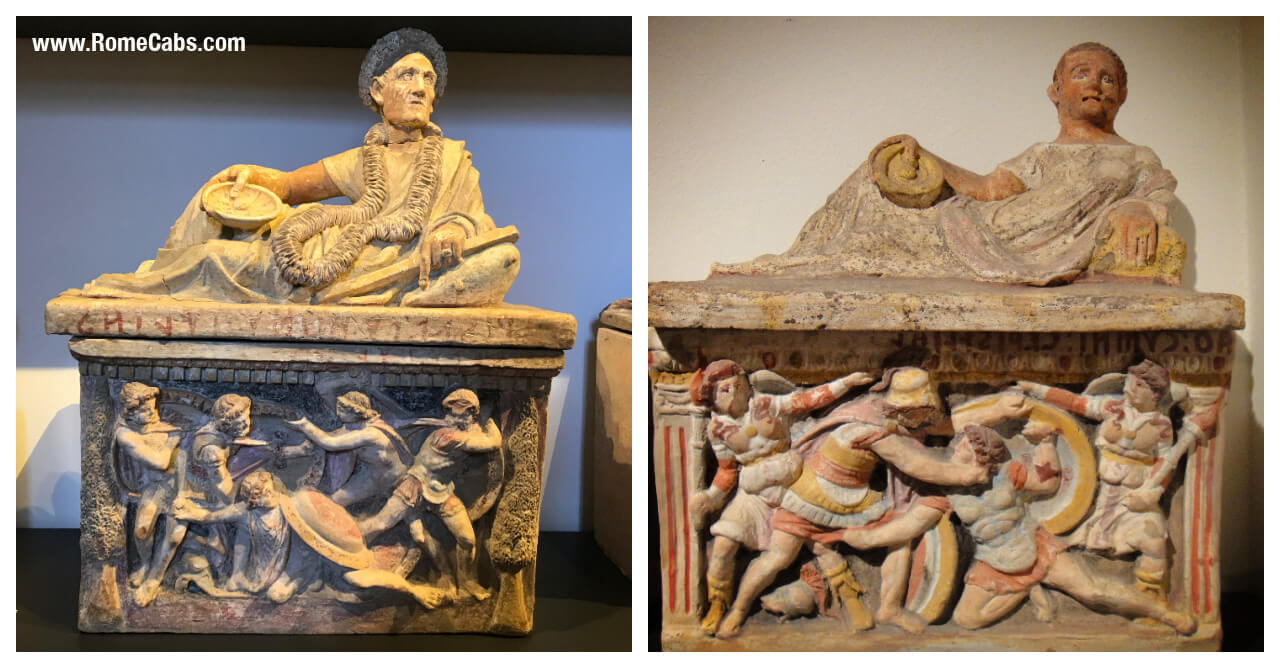
It is also possible that the spouses held organic objects associated with symbolism that is so characteristic of the Etruscans.
For example in ancient frescoes discovered in the tombs of the Monterozzi Necropolis in Tarquinia featured on our Mysterious Etruscan Countryside Tour, figures in funerary banquets can be observed holding an egg, often seen as a symbol of birth, renewal, and the cycle of life. It represents the potential for new beginnings and the idea of regeneration.
The use of symbols in Etruscan art and funerary rituals reflect their beliefs in the continuation of life beyond death and the cyclical nature of existence.

As you admire its intricacies, let your imagination transport you back in time, where love and artistry converge in a testament to the enduring legacy of the Etruscan civilization.
Why was the Sarcophagus made of Terracotta?
The Sarcophagus of the Spouses found in Cerveteri was made of terracotta for several reasons. Firstly, terracotta was a readily available material in the region of Etruria where Cerveteri is located. The Etruscans, who inhabited this area, had access to abundant clay deposits, making terracotta a practical and easily accessible medium for their artistic creations.
Secondly, the Etruscans had a rich tradition and expertise in working with terracotta. They had developed advanced techniques in clay modeling, sculpting, and firing, allowing them to create intricate and detailed artworks. Terracotta provided them with the flexibility to sculpt and shape their artistic visions with precision.
Moreover, terracotta offered practical advantages for funerary art. It was a durable material that could withstand the test of time, preserving the sculptures and inscriptions on the sarcophagus for centuries. Its ability to retain vibrant colors through painting and glazing allowed for the creation of visually striking and expressive artworks.
Overall, the use of terracotta for the Sarcophagus of the Spouses was influenced by its availability, artistic tradition, and practical considerations, making it a fitting choice for conveying Etruscan beliefs and honoring the deceased.
A Window into Ancient Etruscan Funerary Practices:
A glimpse into the ancient Etruscan culture reveals their profound reverence for the deceased and their elaborate funerary practices. At the heart of their rituals lay the solemn act of cremation, a significant and meaningful way to honor and preserve the remains of their loved ones. This cherished tradition sheds light on the depth of their beliefs and the importance they placed on caring for the departed.
The Etruscans, renowned for their intricate tombs and awe-inspiring funerary art, dedicated considerable resources to ensure a dignified resting place for their deceased. Their burial grounds, often referred to as "cities of the dead" or necropolises such as Banditaccia Necropolis in Cerveteri and Monterozzi Necropolis in Tarquinia, bear witness to the profound respect they held for the afterlife.
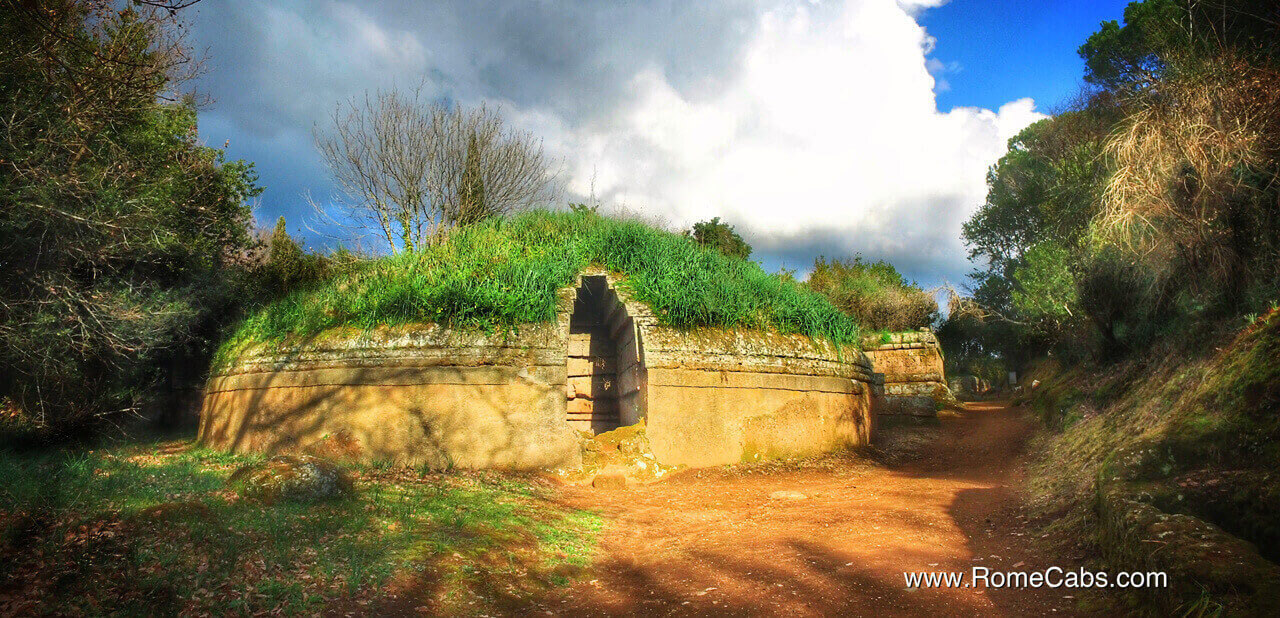
Cremation emerged as the primary funerary practice among the Etruscans. Following the passing of a loved one, the Etruscans would carefully collect the ashes and bones and place them within a cinerary urn or ash urn. These containers served as vessels of remembrance, safeguarding the essence of the departed.
The Villanovans, a people integral to Etruscan culture, crafted distinctive biconical urns. These urns, hand-shaped without the use of a potter's wheel, exhibited a raw and unrefined beauty.
Echoing the architectural styles of their homes, the Etruscans even created clay huts to house the remains of their loved ones. These miniature abodes that can be explored in Cerveteri on our Countryside Splendor Tour, are reminiscent of the dwellings they occupied in life.
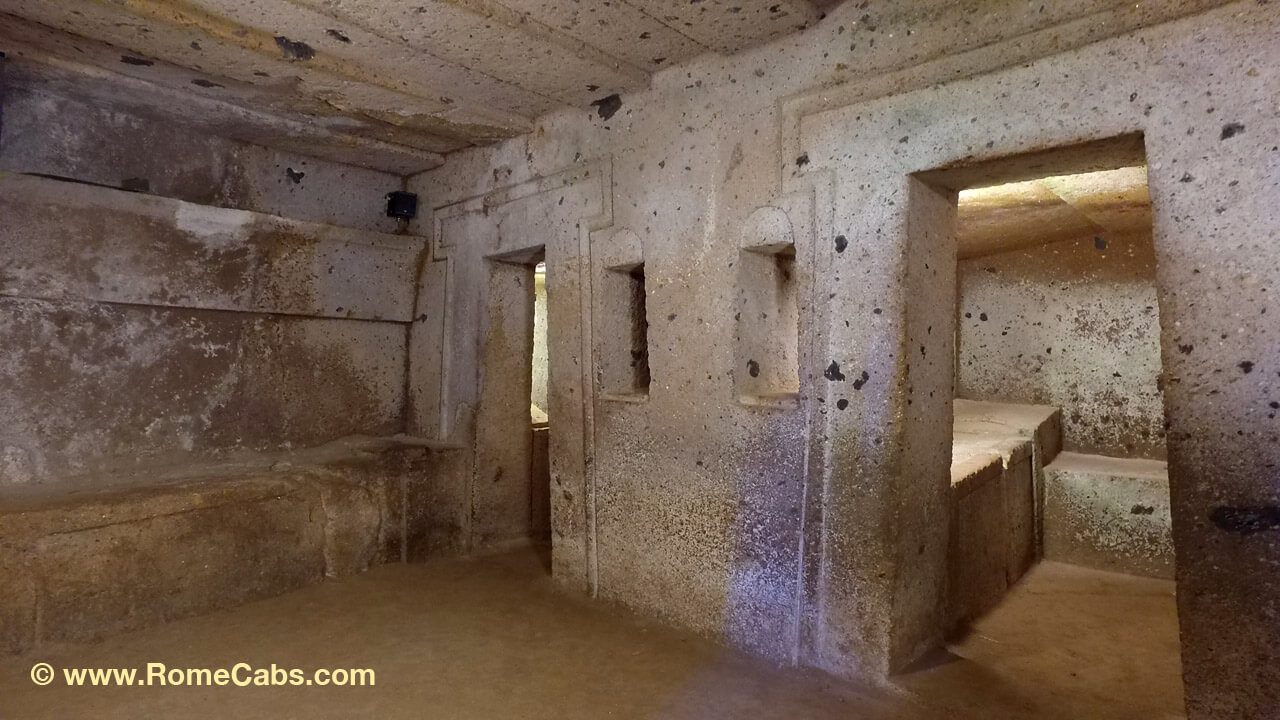
It was not uncommon for personal belongings, such as weapons for men or jewelry for women, to be placed alongside the cremated remains within these huts, adding a personal touch to the final resting place.
Through archaeological excavations, various forms of Etruscan hut urns have been discovered, housing the ashes and bone fragments of both males and females. Grave goods discovered inside the tombs were collected to be studied and displayed in museums.
It is reasonable to presume that the Sarcophagus of the Spouses, with its profound symbolism and artistic significance, would have once contained the cremated remains of individuals held dear.
Family Importance in Etruscan Funerary Practices
The Etruscans placed a significant emphasis on family ties within their society. The elaborate construction of tombs, including the exquisite sarcophagus depicting a couple, highlights the importance they placed on familial connections.
The choice of funerary urns, the materials used, the scale of the urn or sarcophagus, and the inclusion of imagery all contribute to the depiction of social ties within the Etruscan culture.
Inscriptions were often employed to signify family or clan names, either engraved on the exterior of the tomb or accompanied by personal belongings. These inscriptions served as a testament to the enduring bonds of kinship. As we delve into the intricate world of Etruscan burial practices, we encounter a profound and enduring family value: the belief in eternal familial unity.
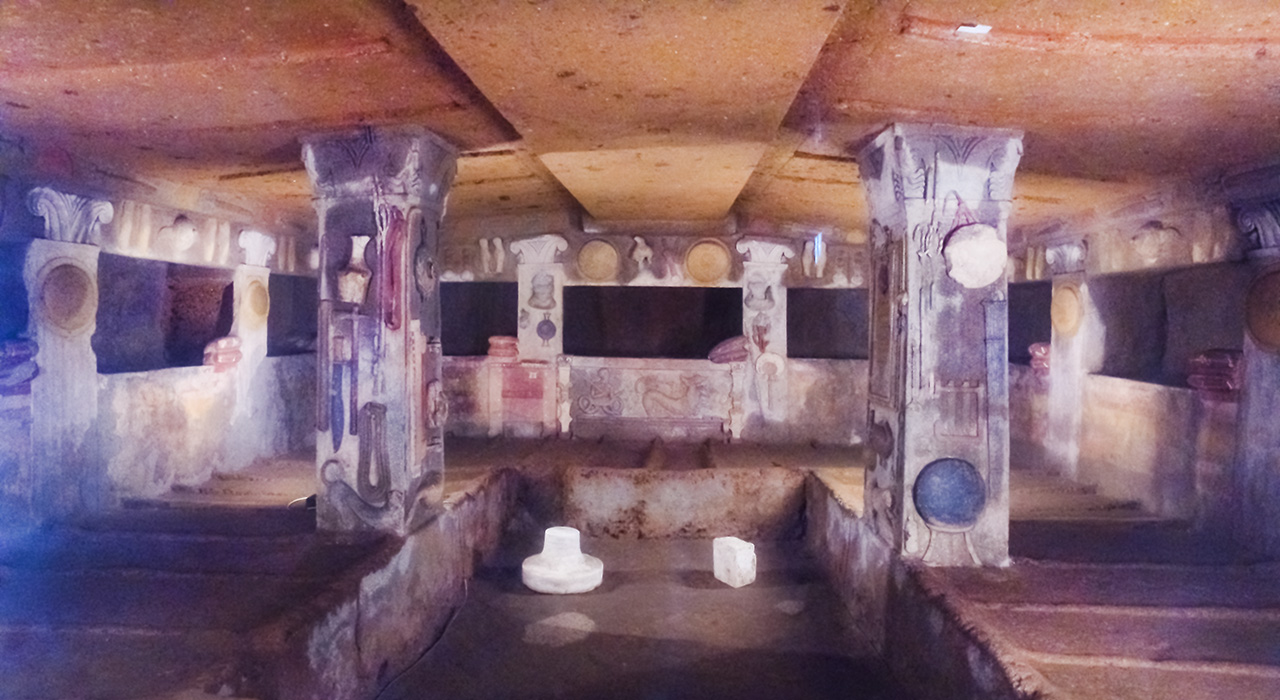
Here, many burial tombs were carefully constructed to accommodate entire families, reflecting the Etruscans' strong bonds and commitment to preserving familial ties in the afterlife. These tombs, characterized by either a grand singular chamber or multiple interconnected smaller chambers, served as eternal resting places for generations, forever etching the importance of family unity into the fabric of Etruscan culture.
Other types of sarcophagi bear significant family connotations. For instance, the rock-carved funerary beds discovered at Banditaccia Necropolis, the very site where the Sarcophagus of the Spouses was unearthed, hold particular significance.
These distinctive sarcophagi possessed distinct characteristics indicating the gender of those interred within. When positioned on the left side of a tomb, the rock-carved sarcophagus was intended for a male, while placement on the right designated a female burial.
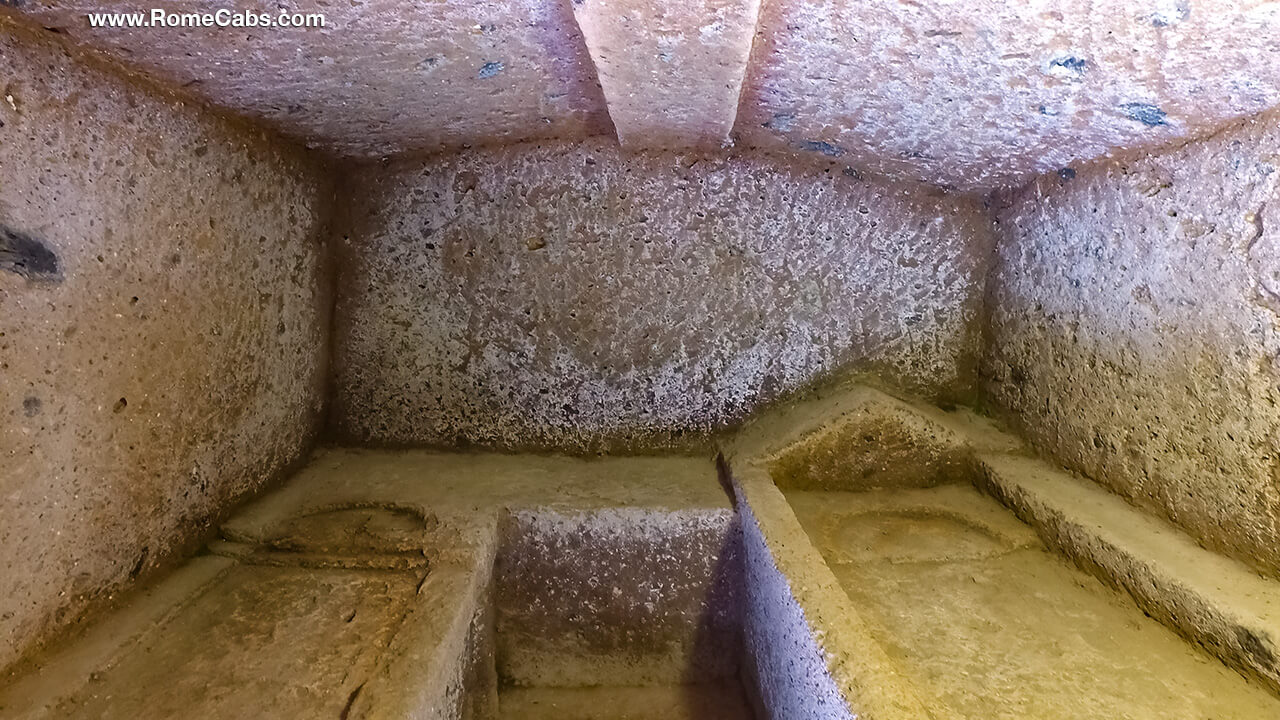
The male sarcophagus resembled a wooden bed, with flat ends and cylindrical legs, emulating the appearance of an actual piece of furniture. On the other hand, the female sarcophagus took on a house-like structure, with triangular-shaped raised ends resembling roofing.
Moreover, smaller sarcophagi presumed to be for children have been discovered near the burial sites of women, further emphasizing the Etruscans' focus on preserving familial identity.
Ancient Etruscan Funerary Banquets
The Sarcophagus of the Spouses offers a captivating glimpse into a banqueting scene, where the couple is depicted reclining together on a single dining couch while indulging in banquet festivities.
This portrayal highlights the importance of conviviality in Etruscan mortuary rituals and underscores the significance of communal gatherings. Etruscan funerary art often showcases scenes of revelry, serving as a symbolic representation of the funeral banquet that ensured a smooth transition to the afterlife. This is evident in the vibrantly painted tombs such as those in Monterozzi Necropolis in Tarquinia, which is included in our Mysterious Etruscans Countryside Tour.
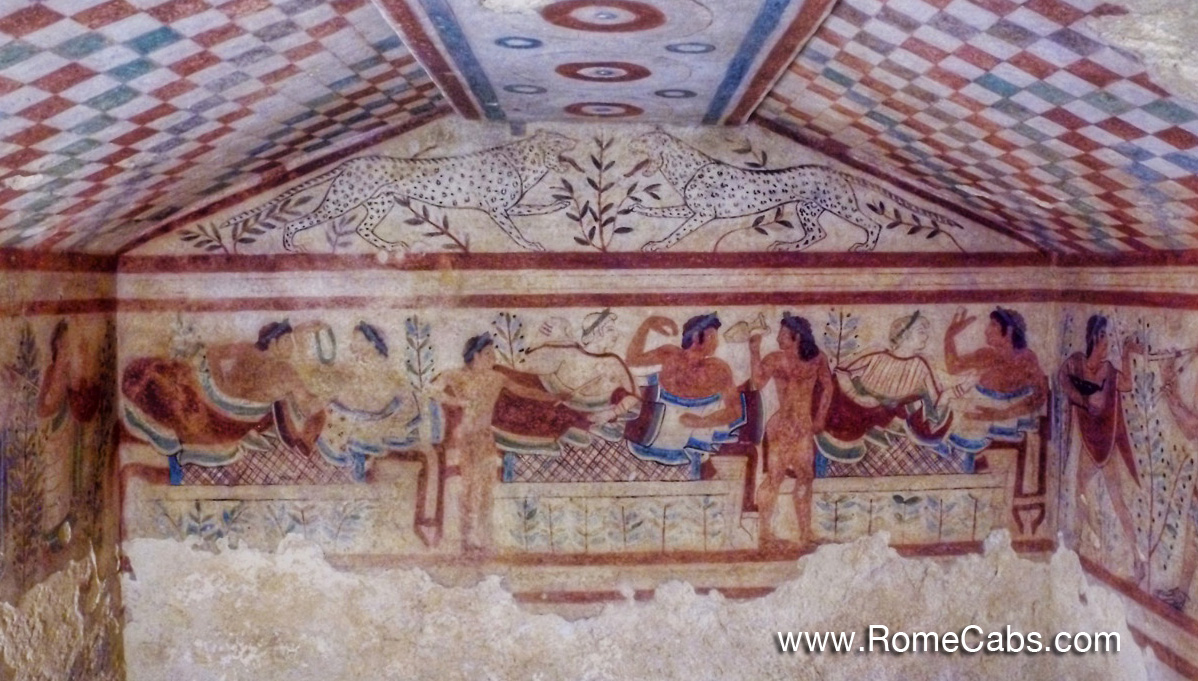
This portrayal also challenges traditional gender norms and reflects the more egalitarian status of women in Etruscan society. We find numerous examples of mixed-gender banquets depicted across different time periods, suggesting that this was a common and accepted practice in Etruria.
Role of Women in the Ancient Etruscan Society
While our knowledge of Etruscan society still remains limited, fascinating glimpses into the lives of Etruscan women have emerged from archaeological discoveries dating back to the Orientalizing period. These findings indicate that women of higher Etruscan society held a status equal to that of men, a departure from the norms of many contemporary civilizations like the Romans and Greeks.
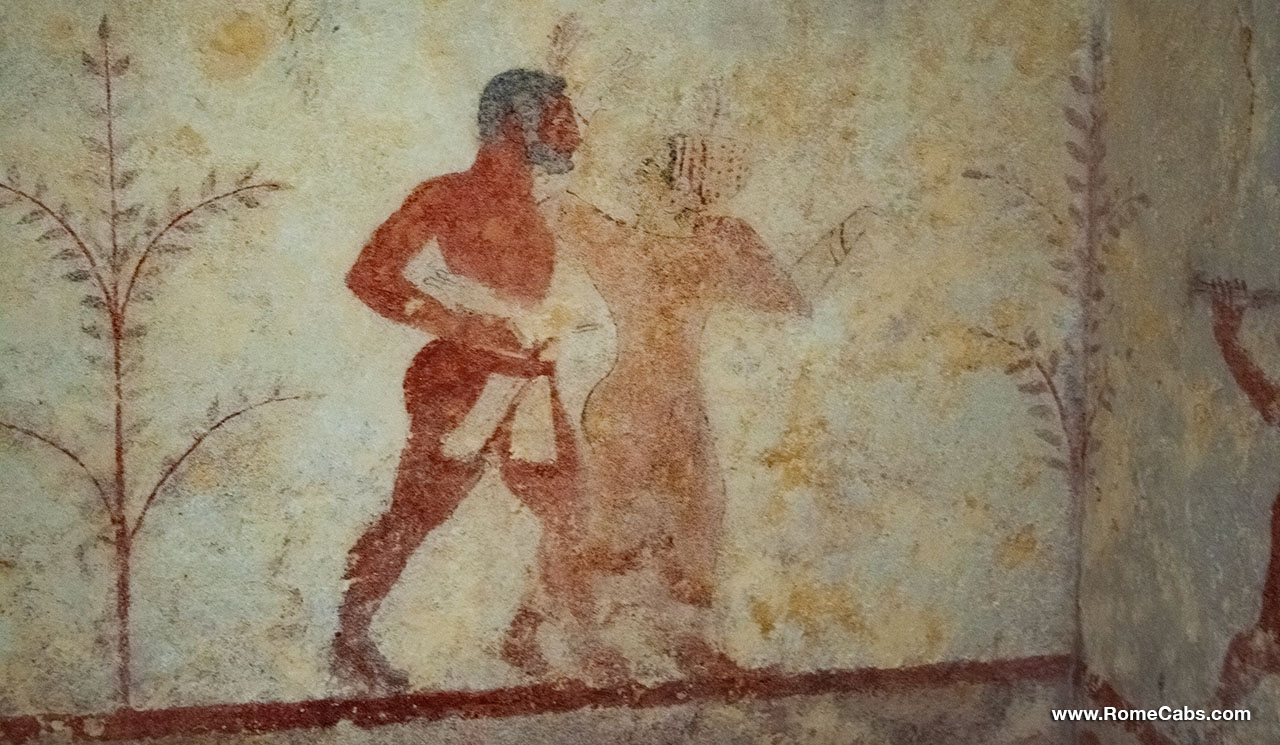
One intriguing aspect of Etruscan women's lives can be observed through their burials, which often showcased a greater level of opulence. This suggests that women of higher status were accorded significant respect and importance within their society.
Additionally, pottery adorned with inscriptions bearing both their individual name (praenomen) and their family name (nomen) has been unearthed, providing further evidence of their recognition and individuality. It is worth noting that personal names were typically reserved for free women, highlighting their autonomy and social standing.
Moreover, it is apparent that women from esteemed Etruscan households possessed a level of literacy. This discovery challenges prevailing notions of gender roles during that era, as it reveals that Etruscan women had the ability to read and write—an exceptional accomplishment for the time. Their literacy further underscores the high regard in which they were held within society.
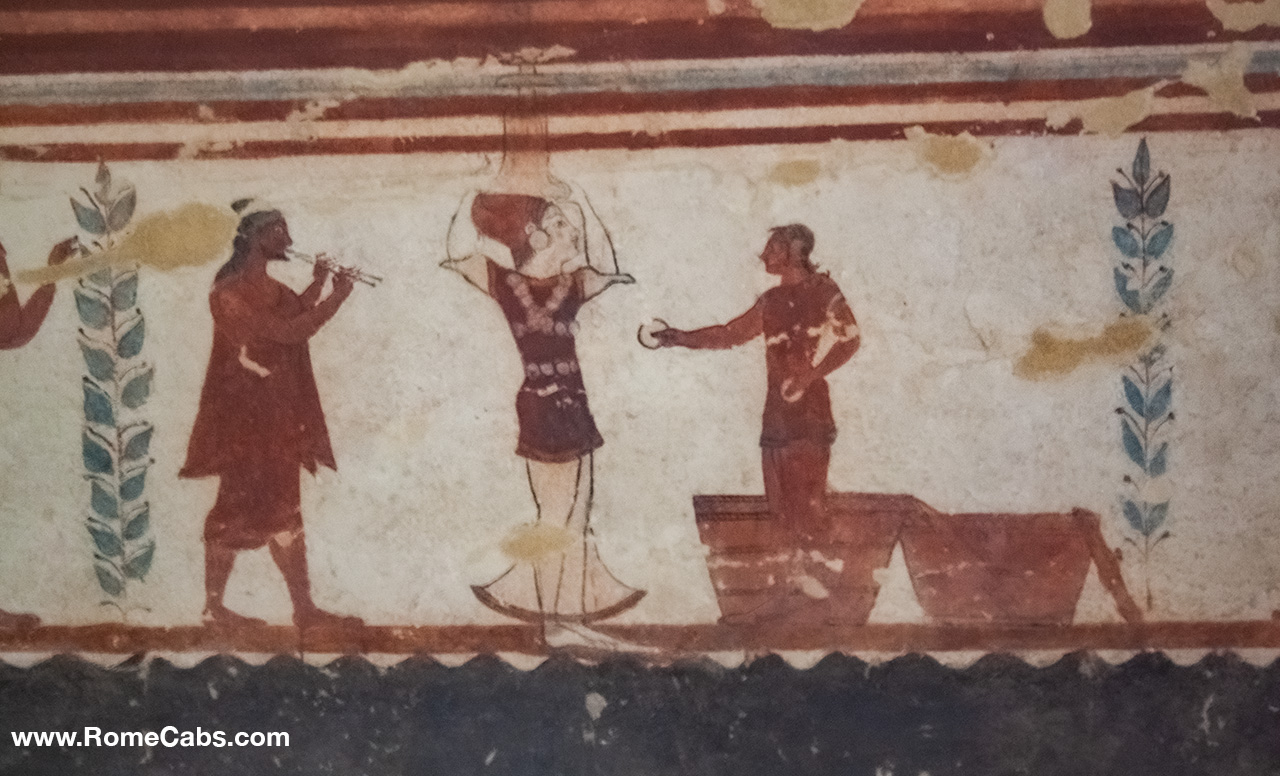
It is worth noting that this unique aspect of Etruscan culture drew criticism and even hostility from Greek and Roman authors of antiquity, who viewed it as not only different but offensive. The elevated status and privileges enjoyed by women in Etruscan society set them apart from their Greek and Roman counterparts, fueling further intrigue and fascination with this enigmatic civilization.
Legacy & Influence of Sarcophagus of the Spouses
Beyond its artistic merits, the Sarcophagus of the Spouses holds a broader historical significance. It serves as a reminder of the Etruscans' enduring impact on later civilizations, including the Romans. Their artistic traditions, religious practices, and social customs influenced Roman culture and played a crucial role in shaping the trajectory of Western civilization.
The Sarcophagus of the Spouses stands as a testament to the artistic brilliance and cultural practices and beliefs of the Etruscan civilization. Through its exquisite craftsmanship, this masterpiece offers a glimpse into the Etruscan way of life, their beliefs about the afterlife, and the importance they placed on family values, love, and companionship.
As we learn more about the Sarcophagus of the Spouses and even admire it in person, we deepen our appreciation for the rich heritage of the Etruscan civilization and their lasting impact on the ancient world.
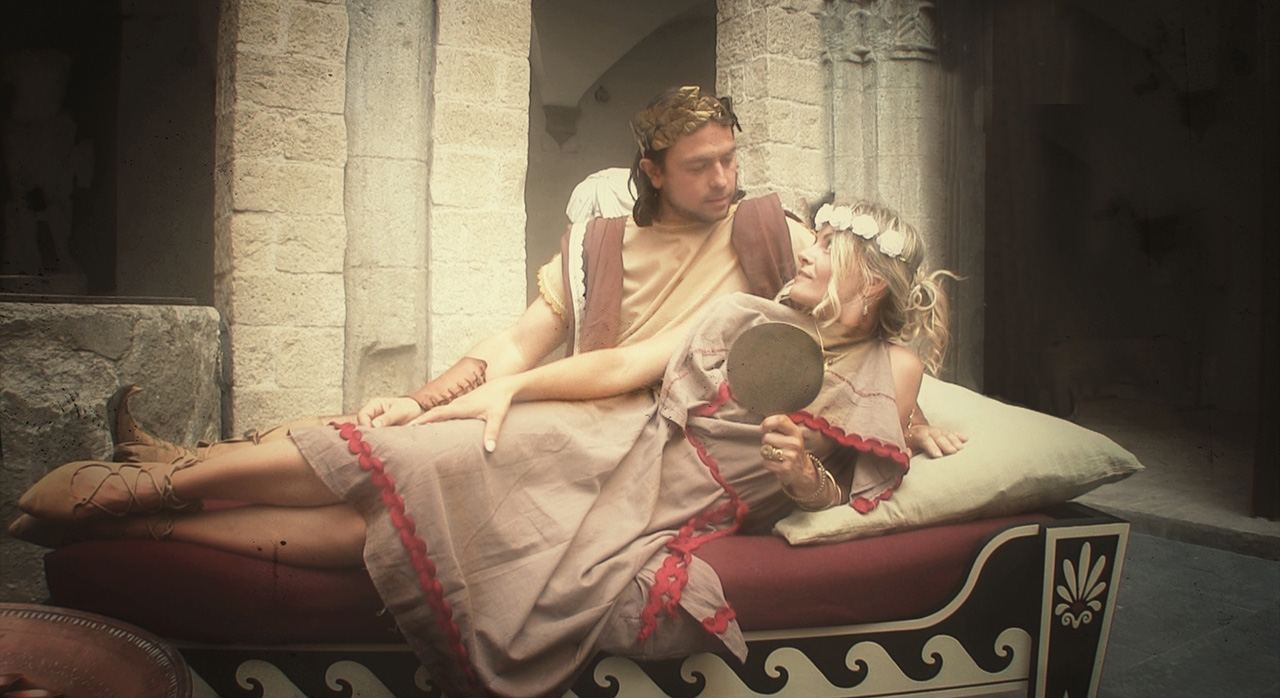
Embark on a remarkable journey through the enchanting world of the Etruscan Civilization with our exclusive limousine private tours. Experience the glory of the Etruscan countryside on our Countryside Splendor Tour or delve into the mysteries of the Etruscans on our captivating Mysterious Etruscans Countryside Tour.
Alternatively, choose our Panoramic Rome Tour, where you have the flexibility to visit the renowned Villa Giulia Museum and witness the awe-inspiring Sarcophagus of the Spouses in person.
Unveil the secrets of these enigmatic ancient people as you join us on an extraordinary tour adventure with Stefano’s RomeCabs and create memories that will last a lifetime.
